UiPath Bundle
How Did UiPath Become an Automation Giant?
UiPath, a titan in enterprise automation and AI, is reshaping how businesses operate. From its inception in 2005, UiPath has revolutionized industries with its Robotic Process Automation (RPA) and AI-driven solutions. This journey, from a Bucharest apartment to a global leader, is a story of innovation and relentless growth.
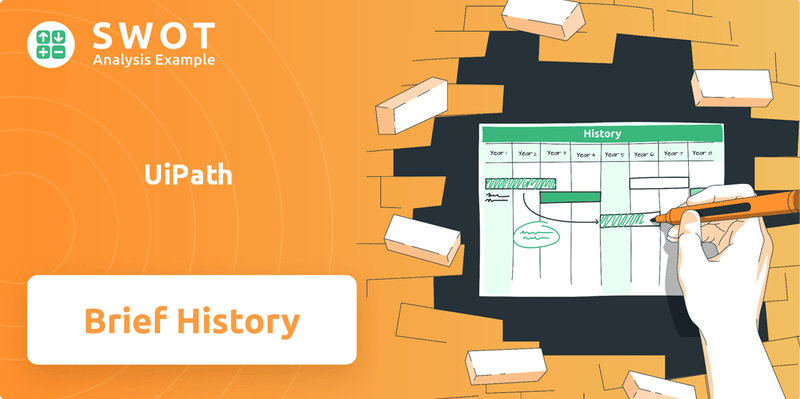
UiPath's story began with a vision to transform repetitive tasks, evolving into a platform that leverages AI and machine learning. This platform empowers software robots to handle tasks, freeing up human potential. To understand its market position and strategic direction, consider a detailed UiPath SWOT Analysis. This introduction sets the stage for a deep dive into the UiPath history, exploring the UiPath company milestones, and the impact of UiPath on the automation landscape.
What is the UiPath Founding Story?
The story of UiPath begins in Bucharest, Romania. It is a tale of innovation and adaptation in the tech industry.
Founded in 2005, the company started as DeskOver. It was a small operation with big ambitions.
The founders, Daniel Dines and Marius Tîrcă, laid the groundwork for what would become a leader in Robotic Process Automation (RPA).
Initially, DeskOver focused on automation libraries and software development kits. They served major tech players.
- For nearly a decade, the team bootstrapped operations from a Bucharest apartment.
- A key moment arrived between 2012 and 2013. The team saw an opportunity in RPA.
- This led to a strategic shift towards building a platform for software robots.
- In 2015, the company rebranded to UiPath, reflecting its new focus.
The early years involved a lot of hard work. The team was small, but they were determined. They sought product-market fit, a critical step for any startup.
The pivot to RPA was a smart move. It positioned UiPath at the forefront of a growing market. The company's ability to adapt was key to its success.
UiPath secured its Series A funding in 2017. This was a significant milestone.
- The Series A round raised $30 million from Accel.
- This funding fueled the company's early financial growth.
- The founders' technical backgrounds and vision were crucial.
- They recognized and adapted to the RPA market.
The early funding round was a major boost. It provided the resources needed to scale up operations. The company's growth trajectory was set.
UiPath's journey is a testament to the power of innovation. It's also a story of adapting to market trends. The company's success is a result of vision and hard work. Learn more about the Owners & Shareholders of UiPath.
UiPath SWOT Analysis
- Complete SWOT Breakdown
- Fully Customizable
- Editable in Excel & Word
- Professional Formatting
- Investor-Ready Format
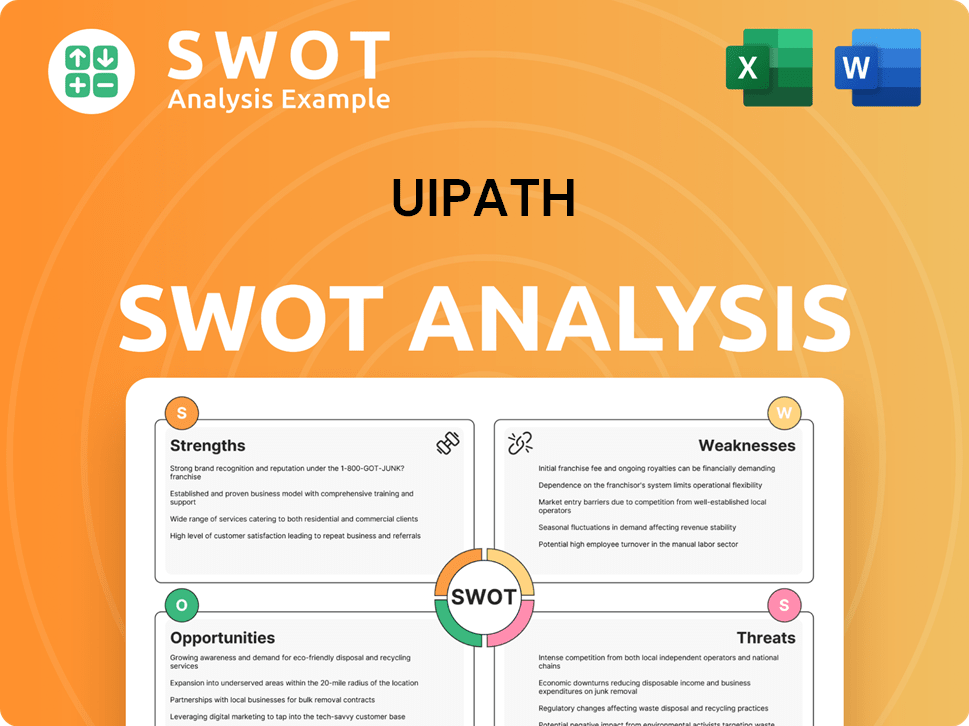
What Drove the Early Growth of UiPath?
Following its strategic pivot to Robotic Process Automation (RPA) and rebranding in 2015, the UiPath company experienced a period of rapid expansion. This growth was fueled by its user-friendly automation tools, which resonated particularly well with large enterprises. This accessibility drove the adoption of an 'automation first mindset' within businesses, significantly impacting its early success.
The company's international expansion began in 2015 with offices in London and New York City. Further offices were established in Bangalore, Paris, Singapore, Washington D.C., and Tokyo. This expansion was supported by substantial funding rounds, including a $30 million Series A in 2017.
In 2018, UiPath secured $153 million in Series B and $225 million in Series C funding. The company's valuation reached $7 billion after a $568 million Series D funding round in 2019. These funding rounds significantly contributed to the company's growth and market position.
As of Q2 2025, UiPath had a customer base of 10,810. The number of customers with Annual Recurring Revenue (ARR) exceeding $100,000 and $1 million also increased. Annual revenue for fiscal year 2025 reached $1.43 billion USD, a 9.3% increase from 2024.
Strategic partnerships with companies like SAP and Microsoft strengthened UiPath's market position. These partnerships involved embedding UiPath's automation into broader enterprise ecosystems. These efforts, combined with operational efficiency, shaped its trajectory as a dominant force in the automation market, as further detailed in the Growth Strategy of UiPath.
UiPath PESTLE Analysis
- Covers All 6 PESTLE Categories
- No Research Needed – Save Hours of Work
- Built by Experts, Trusted by Consultants
- Instant Download, Ready to Use
- 100% Editable, Fully Customizable
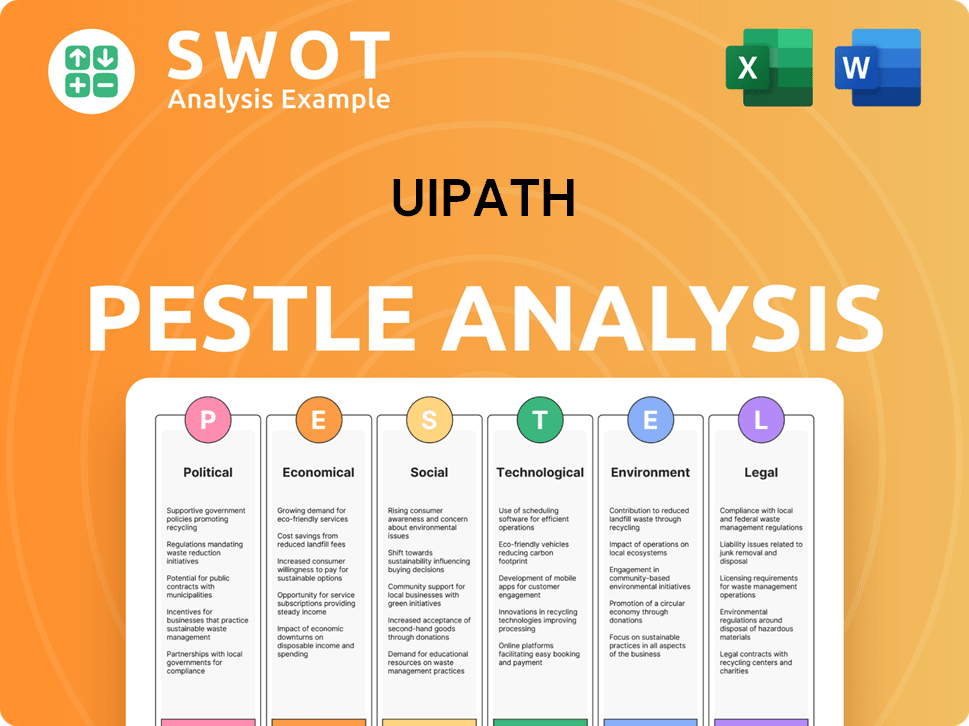
What are the key Milestones in UiPath history?
The UiPath company has a rich history, marked by significant achievements and strategic shifts in the automation landscape. The company's journey reflects its commitment to innovation and adaptation in a dynamic market.
| Year | Milestone |
|---|---|
| 2005 | UiPath was founded in Bucharest, Romania, initially focusing on providing software for other companies. |
| 2015 | The company shifted its focus to Robotic Process Automation (RPA), developing its core platform. |
| 2018 | UiPath secured significant funding rounds, accelerating its growth and market expansion. |
| 2021 | UiPath went public, listing on the New York Stock Exchange under the ticker symbol PATH. |
| 2023 | UiPath achieved FedRAMP certification for its Agentic Automation Platform, expanding its reach to federal agencies. |
UiPath has consistently innovated, evolving from traditional RPA to an AI-driven automation platform. A key innovation is the move towards 'agentic automation,' integrating large language models and third-party AI orchestration.
Autopilot allows non-technical users to build automations using natural language, democratizing access to automation. This feature is a significant step towards making automation more accessible.
Agent Builder is another groundbreaking product, enabling the creation of intelligent agents. This tool enhances the capabilities of automation processes.
Agentic Orchestration is designed to manage and coordinate multiple agents, optimizing workflow efficiency. It provides a central hub for agent management.
Agentic Testing ensures the reliability and effectiveness of automated processes through rigorous testing. This is critical for maintaining automation quality.
UiPath has formed strategic partnerships with companies like SAP, Inflection AI, Deloitte, and HCLTech. These collaborations expand its market reach and enhance its product offerings.
UiPath has focused on integrating large language models (LLMs) and third-party AI orchestration to enhance security and mission readiness. This is particularly crucial in the public sector.
Despite its successes, UiPath has faced challenges, including competition from tech giants and economic uncertainties. The company has responded by shifting towards agentic AI and implementing strategic measures.
UiPath faces competition from Microsoft (Power Automate), Automation Anywhere, and Blue Prism. These competitors have a significant presence in the RPA market.
Global economic uncertainty, particularly in the U.S. public sector, has impacted UiPath's revenue growth and guidance. This has led to strategic adjustments.
The potential impact of generative AI models on the traditional RPA business model has presented concerns. UiPath is addressing this by integrating AI capabilities.
UiPath has strategically shifted to agentic AI, combining AI, automation, and orchestration to enable agents to plan, work, and make decisions with minimal human oversight. This is a key response to market dynamics.
The company has undertaken restructuring and cost-cutting measures to improve efficiency and profitability. These actions aim to streamline operations.
UiPath has focused on strengthening its sales and customer support, leading to improved contract execution and new deals. This enhances customer relationships.
UiPath Business Model Canvas
- Complete 9-Block Business Model Canvas
- Effortlessly Communicate Your Business Strategy
- Investor-Ready BMC Format
- 100% Editable and Customizable
- Clear and Structured Layout
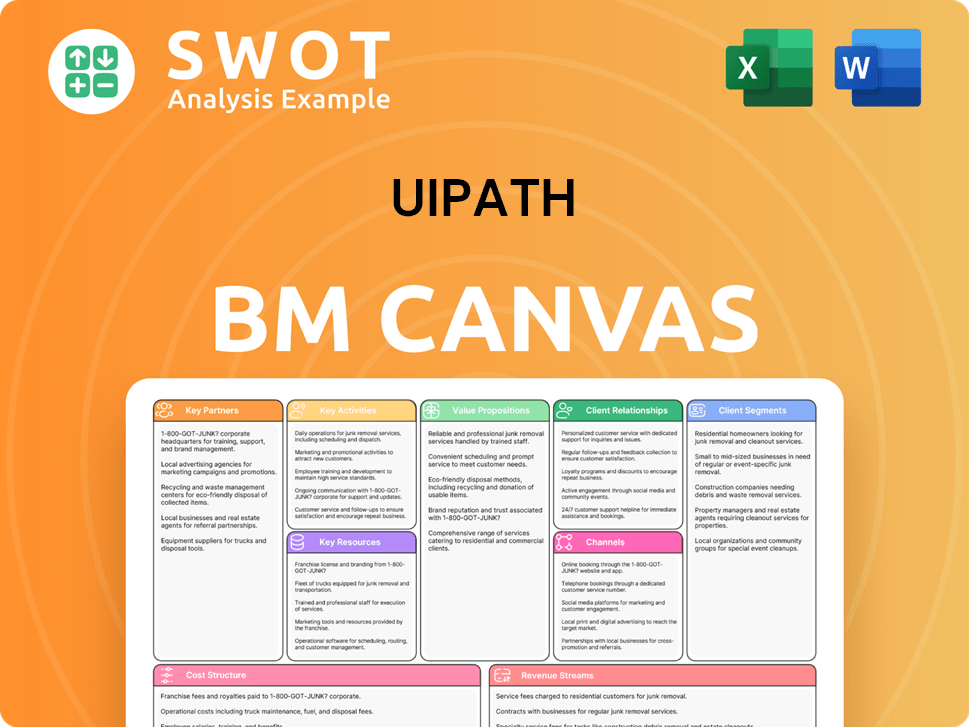
What is the Timeline of Key Events for UiPath?
The journey of the UiPath company is marked by strategic pivots and significant achievements, evolving from its inception as DeskOver in 2005 to a global leader in Robotic Process Automation (RPA) and, more recently, agentic automation. This evolution underscores the company's ability to adapt and innovate within the rapidly changing technology landscape.
| Year | Key Event |
|---|---|
| 2005 | Founded as DeskOver in Bucharest, Romania, by Daniel Dines and Marius Tîrcă. |
| 2012-2013 | Shifts focus to Robotic Process Automation (RPA) product development. |
| 2015 | Rebrands from DeskOver to UiPath; opens offices in London and New York City, marking international expansion. |
| 2017 | Secures $30 million in Series A funding from Accel. |
| 2018 | Raises $153 million in Series B and $225 million in Series C funding. |
| 2019 | Secures $568 million in Series D funding, increasing valuation to $7 billion. |
| April 21, 2021 | Becomes a public company with an initial public offering (IPO). |
| October 2024 | Announces new vision and strategic direction centered on agentic automation. |
| December 2024 | UiPath unveils 2025 AI and automation trends, highlighting agentic AI. |
| January 31, 2025 | Reports Annual Recurring Revenue (ARR) of $1.666 billion, a 14% year-over-year increase. |
| February 2025 | Accelerates agentic AI strategy, integrating LLMs and launching UiPath Autopilot. |
| March 2025 | Reports full year fiscal 2025 revenue of $1.43 billion, a 9% increase year-over-year; announces acquisition of Peak AI Limited. |
| April 2025 | Global systems integrator (GSI) partners present at UiPath's annual DevCon event; over 40 partners complete agentic 'fast track' training program. |
| May 2025 | UiPath expands its R&D footprint in India and continues to focus on vertical AI specialization. |
UiPath is heavily invested in agentic automation, a strategy that integrates AI agents, robots, and human input. The company aims to accelerate innovation within this framework. This approach is expected to drive operational efficiencies and enhance customer adoption of new technologies.
UiPath projects a revenue range of $1.525 billion to $1.530 billion for fiscal year 2026. The company anticipates ARR to be between $1.816 billion and $1.821 billion by January 31, 2026. While the first half of fiscal year 2026 may see slower growth, the latter half is expected to perform better.
UiPath is focused on R&D to create new AI-powered features, including Autopilot for Everyone and Clipboard AI. Strategic partnerships, such as those with Microsoft and Deloitte, are crucial. These collaborations are designed to broaden UiPath’s capabilities and market reach.
UiPath plans to specialize in vertical AI, leveraging internal capabilities and strategic partnerships. This focus aims to tailor automation solutions to specific industry needs. Daniel Dines, CEO, envisions agentic automation redefining enterprise automation.
UiPath Porter's Five Forces Analysis
- Covers All 5 Competitive Forces in Detail
- Structured for Consultants, Students, and Founders
- 100% Editable in Microsoft Word & Excel
- Instant Digital Download – Use Immediately
- Compatible with Mac & PC – Fully Unlocked
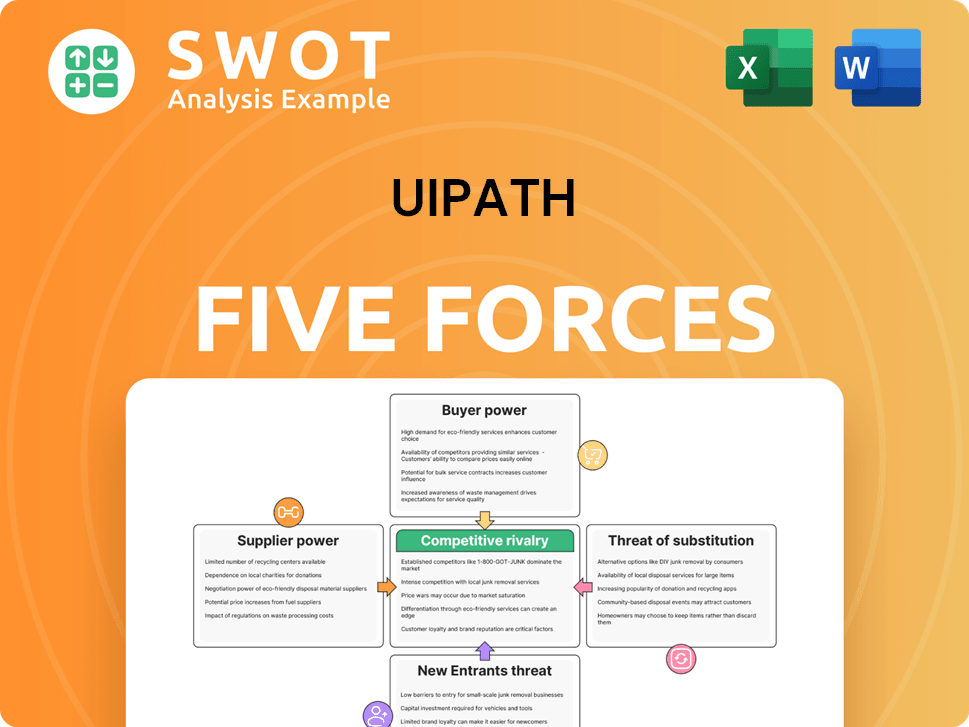
Related Blogs
- What is Competitive Landscape of UiPath Company?
- What is Growth Strategy and Future Prospects of UiPath Company?
- How Does UiPath Company Work?
- What is Sales and Marketing Strategy of UiPath Company?
- What is Brief History of UiPath Company?
- Who Owns UiPath Company?
- What is Customer Demographics and Target Market of UiPath Company?
Disclaimer
All information, articles, and product details provided on this website are for general informational and educational purposes only. We do not claim any ownership over, nor do we intend to infringe upon, any trademarks, copyrights, logos, brand names, or other intellectual property mentioned or depicted on this site. Such intellectual property remains the property of its respective owners, and any references here are made solely for identification or informational purposes, without implying any affiliation, endorsement, or partnership.
We make no representations or warranties, express or implied, regarding the accuracy, completeness, or suitability of any content or products presented. Nothing on this website should be construed as legal, tax, investment, financial, medical, or other professional advice. In addition, no part of this site—including articles or product references—constitutes a solicitation, recommendation, endorsement, advertisement, or offer to buy or sell any securities, franchises, or other financial instruments, particularly in jurisdictions where such activity would be unlawful.
All content is of a general nature and may not address the specific circumstances of any individual or entity. It is not a substitute for professional advice or services. Any actions you take based on the information provided here are strictly at your own risk. You accept full responsibility for any decisions or outcomes arising from your use of this website and agree to release us from any liability in connection with your use of, or reliance upon, the content or products found herein.